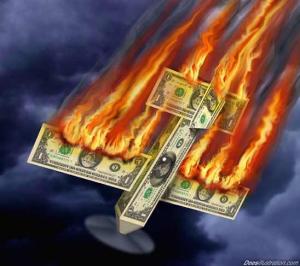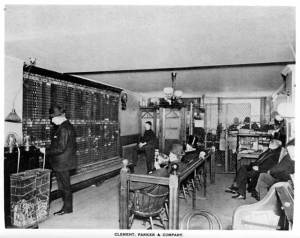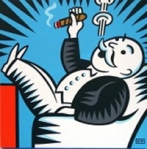 October 27 2008 Real estate has always been cyclical and we’ve been in what looked like a routine down cycle since mid-2006. Real estate has also been the engine of the greater economy with new homeowners buying appliances, furniture, building materials and more – boosting production and creating jobs. So it’s never been surprising when a slow real estate market slows everything down. But how in the world did this real estate bust ever bring down the biggest Wall Street firms and lead to the global economic disaster we’re in today? And why hasn’t this ever happened before? And what are all these new terms we’re hearing like “sub-prime mortgages”, “mortgage-backed securities” and “credit default swaps”? It can all seem mind-boggling, but it’s really quite simple.
October 27 2008 Real estate has always been cyclical and we’ve been in what looked like a routine down cycle since mid-2006. Real estate has also been the engine of the greater economy with new homeowners buying appliances, furniture, building materials and more – boosting production and creating jobs. So it’s never been surprising when a slow real estate market slows everything down. But how in the world did this real estate bust ever bring down the biggest Wall Street firms and lead to the global economic disaster we’re in today? And why hasn’t this ever happened before? And what are all these new terms we’re hearing like “sub-prime mortgages”, “mortgage-backed securities” and “credit default swaps”? It can all seem mind-boggling, but it’s really quite simple.
In the good ol’ days, your local bank gave you a mortgage for your home and you paid that very same bank back over the next 30-odd years. You may have done all your banking with this particular bank and you and your wife may have even played bridge or tennis with your banker and his wife. Beaver and Opie lived down the street, Donna Reed greeted you at the door in a crisp shirtdress and pearls, Hazel cooked and cleaned while doling-out sassy back-talk, and Father always Knew Best.
For better or worse, those days are long gone. The Republican revolution of the 1980s led by Ronald Reagan followed by Newt Gingrich’s “Contract With America” ushered in a new wave of “small government” and pro-business thinking in Washington. Deregulation became the magic elixir and Wall Street embraced the mantra of “greed is good”. One of the things this new deregulation did was allow banks to sell their mortgages to larger banks, who in turn packaged them together and sold portfolios of  these mortgages to investors in financial instruments called “mortgage backed securities”. Some of these portfolios were made up of better quality mortgages, and some of lower quality mortgages and they were rated according to risk. This new packaging of bad loans with good loans made it easier for banks to issue riskier loans to less qualified consumers – and with more people flooding into the housing market, house prices shot up like a rocket. Throughout the 1990s, people who had previously been shut out of the
these mortgages to investors in financial instruments called “mortgage backed securities”. Some of these portfolios were made up of better quality mortgages, and some of lower quality mortgages and they were rated according to risk. This new packaging of bad loans with good loans made it easier for banks to issue riskier loans to less qualified consumers – and with more people flooding into the housing market, house prices shot up like a rocket. Throughout the 1990s, people who had previously been shut out of the  American Dream of home ownership were now welcomed with open arms. Those who wondered how they would ever make the payments when their adjustable rate mortgages actually adjusted were reassured that rising home values would enable them to refinance before their payments increased. Why, they could even take money out of a refi and still lower
American Dream of home ownership were now welcomed with open arms. Those who wondered how they would ever make the payments when their adjustable rate mortgages actually adjusted were reassured that rising home values would enable them to refinance before their payments increased. Why, they could even take money out of a refi and still lower  their payments! Houses became giant ATMs – never mind you were simply giving up equity. There were actually financial experts advising people to never pay off a mortgage – that that was “old-fashioned”, “unsophisticated” thinking!
their payments! Houses became giant ATMs – never mind you were simply giving up equity. There were actually financial experts advising people to never pay off a mortgage – that that was “old-fashioned”, “unsophisticated” thinking!
Before I go any further, let’s take a step back further in time – back to the turn of the last century. The “gilded age” of the 1890s was a decade of rising affluence as cities and municipalities grew rapidly to absorb the mushrooming population of immigrants from the previous 20 years, many of whom were now beginning to prosper. As the industrial  revolution took hold, a new wave of manufacturing and service industries grew, and so did the stock market. Investing in stocks became available to the working classes for the first time and with the increase in investors, new investment vehicles sprouted like weeds in a garden. One of these popular new investments was side bets made on the performance of a stock. Without actually buying a stock, you could place a bet that that stock would go up or down. These side bets became known as “derivatives” and they were bought, sold and traded in betting parlors all over the city called “bucket shops”. Since these bucket shops fell outside the scope of federal regulators, nobody was checking to see if the so-called “banks” selling these derivatives had the cash reserves needed to pay off these bets. As the stock market reached a fever pitch in 1907, these derivatives added to the hysteria that led to panic resulting in a stock market crash. So in 1908, this kind of gambling on stocks was made illegal and the bucket shops disappeared. During the depression, even tighter regulation was established by the Securities Exchange Act of 1934.
revolution took hold, a new wave of manufacturing and service industries grew, and so did the stock market. Investing in stocks became available to the working classes for the first time and with the increase in investors, new investment vehicles sprouted like weeds in a garden. One of these popular new investments was side bets made on the performance of a stock. Without actually buying a stock, you could place a bet that that stock would go up or down. These side bets became known as “derivatives” and they were bought, sold and traded in betting parlors all over the city called “bucket shops”. Since these bucket shops fell outside the scope of federal regulators, nobody was checking to see if the so-called “banks” selling these derivatives had the cash reserves needed to pay off these bets. As the stock market reached a fever pitch in 1907, these derivatives added to the hysteria that led to panic resulting in a stock market crash. So in 1908, this kind of gambling on stocks was made illegal and the bucket shops disappeared. During the depression, even tighter regulation was established by the Securities Exchange Act of 1934.
 Now fast-forward to the year 2000. Bill Clinton is a lame-duck President with a Republican-dominated congress. Deregulation is still the mantra and Clinton, a centrist Democrat eager to co-opt the Republican agenda whenever he could, along with his Chairman of the Federal Reserve, Alan Greenspan, enthusiastically signed into law the Commodities Futures Modernization Act of 2000. This not only overturned the 1908 law, but most significantly it removed the trading of derivatives around these new mortgage-backed securities from Federal oversight. Savvy investors could bet that some of these mortgage backed securities would fail as homeowners defaulted on their mortgages. These bets,
Now fast-forward to the year 2000. Bill Clinton is a lame-duck President with a Republican-dominated congress. Deregulation is still the mantra and Clinton, a centrist Democrat eager to co-opt the Republican agenda whenever he could, along with his Chairman of the Federal Reserve, Alan Greenspan, enthusiastically signed into law the Commodities Futures Modernization Act of 2000. This not only overturned the 1908 law, but most significantly it removed the trading of derivatives around these new mortgage-backed securities from Federal oversight. Savvy investors could bet that some of these mortgage backed securities would fail as homeowners defaulted on their mortgages. These bets,  called “credit default swaps”, were invented by JPMorgan in 1994 as a sort of insurance against outstanding corporate loans and to free-up cash to offset the huge cash reserves they were required to keep against those loans. Hedge fund managers trading them had become the new Masters of the Universe. Now credit default swaps could be traded against mortgage backed securities with no federal oversight – meaning no requirement to keep cash reserves to pay them off, unlike credit default swaps against corporate loans and other investments. Real estate was the new lawless wild west town. This further stimulated a market for ever more risky mortgages, throwing more gasoline on the bonfire. By 2006, the housing bubble began to plateau as prices simply became unsustainable. Homeowners who were counting on refinancing before their mortgages became unaffordable suddenly found themselves “upside-down” (owing more on their house than it was worth). Foreclosures started to mount, swelling to a tidal wave that crashed on the beach in September 2008, wiping out everything in its path, including the giant Wall Street firms who had taken to mortgage-backed securities like a junkie on smack. Without the cash reserves they would have been required to hold had they not been deregulated, they were wiped out.
called “credit default swaps”, were invented by JPMorgan in 1994 as a sort of insurance against outstanding corporate loans and to free-up cash to offset the huge cash reserves they were required to keep against those loans. Hedge fund managers trading them had become the new Masters of the Universe. Now credit default swaps could be traded against mortgage backed securities with no federal oversight – meaning no requirement to keep cash reserves to pay them off, unlike credit default swaps against corporate loans and other investments. Real estate was the new lawless wild west town. This further stimulated a market for ever more risky mortgages, throwing more gasoline on the bonfire. By 2006, the housing bubble began to plateau as prices simply became unsustainable. Homeowners who were counting on refinancing before their mortgages became unaffordable suddenly found themselves “upside-down” (owing more on their house than it was worth). Foreclosures started to mount, swelling to a tidal wave that crashed on the beach in September 2008, wiping out everything in its path, including the giant Wall Street firms who had taken to mortgage-backed securities like a junkie on smack. Without the cash reserves they would have been required to hold had they not been deregulated, they were wiped out.
The problem, as Alan Greenspan now points out, is that he and the others in charge had too much faith in the executives running the banking industry. They believed bankers would be responsible to their shareholders and self- regulate. Instead, these executives paid little attention to the details and took delight in paying themselves enormous bonuses – often in excess of $100 million. Now that a conservative Republican, pro-business/small government administration has (ironically) federalized the banking system, we, the taxpayers, will all be paying for that party for decades to come. Will the bailout work? It’s too soon to tell, but the fact that it’s being administered by the very same Wall Street executives who created the mess doesn’t give JetSetRnv8r much faith.
regulate. Instead, these executives paid little attention to the details and took delight in paying themselves enormous bonuses – often in excess of $100 million. Now that a conservative Republican, pro-business/small government administration has (ironically) federalized the banking system, we, the taxpayers, will all be paying for that party for decades to come. Will the bailout work? It’s too soon to tell, but the fact that it’s being administered by the very same Wall Street executives who created the mess doesn’t give JetSetRnv8r much faith.
 Update: Days after writing this post, it was revealed that the first thing the Wall Street firms did with their federal bail-out money was set aside billions of dollars for executive bonuses. Surprised?
Update: Days after writing this post, it was revealed that the first thing the Wall Street firms did with their federal bail-out money was set aside billions of dollars for executive bonuses. Surprised?


